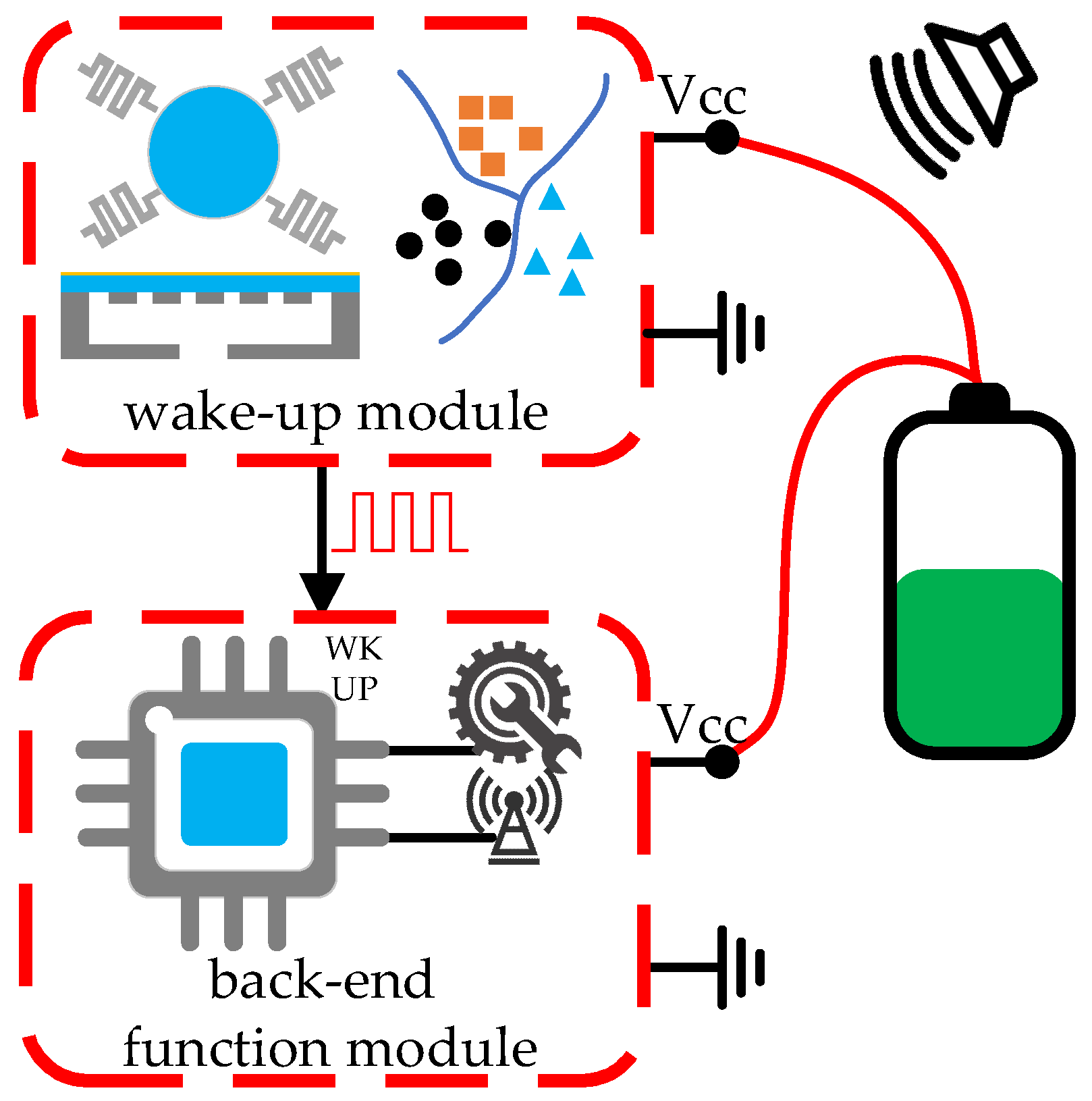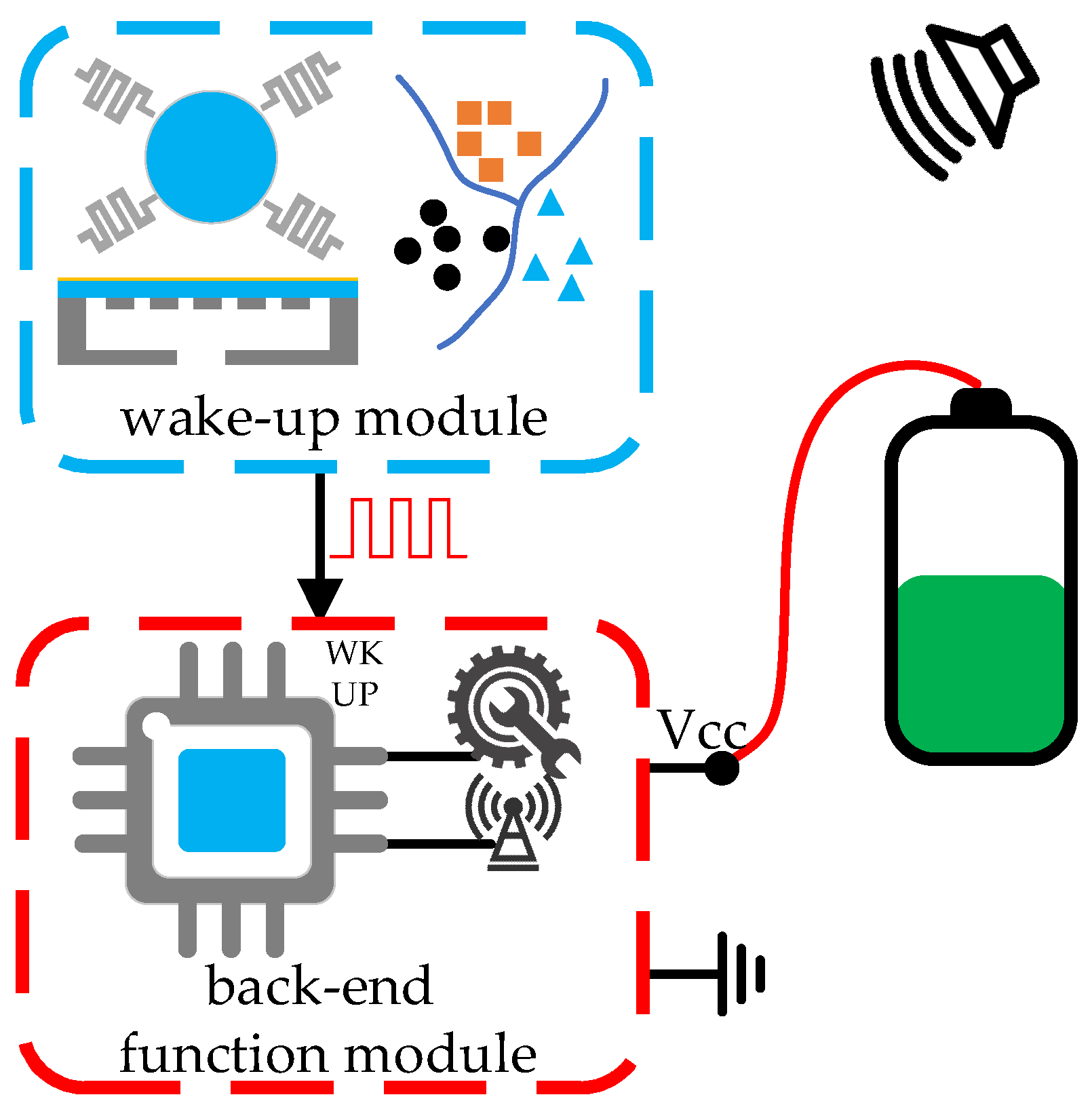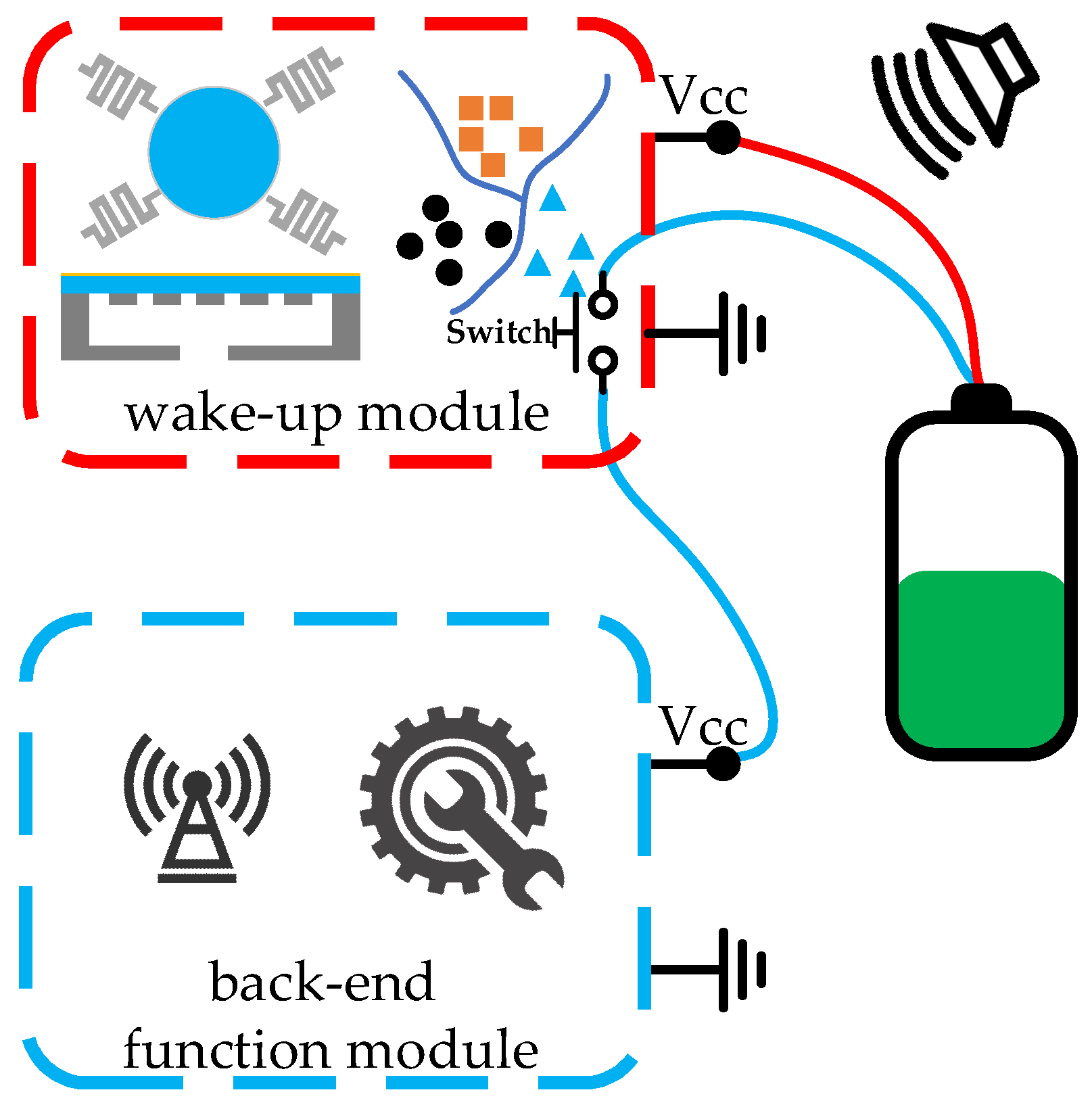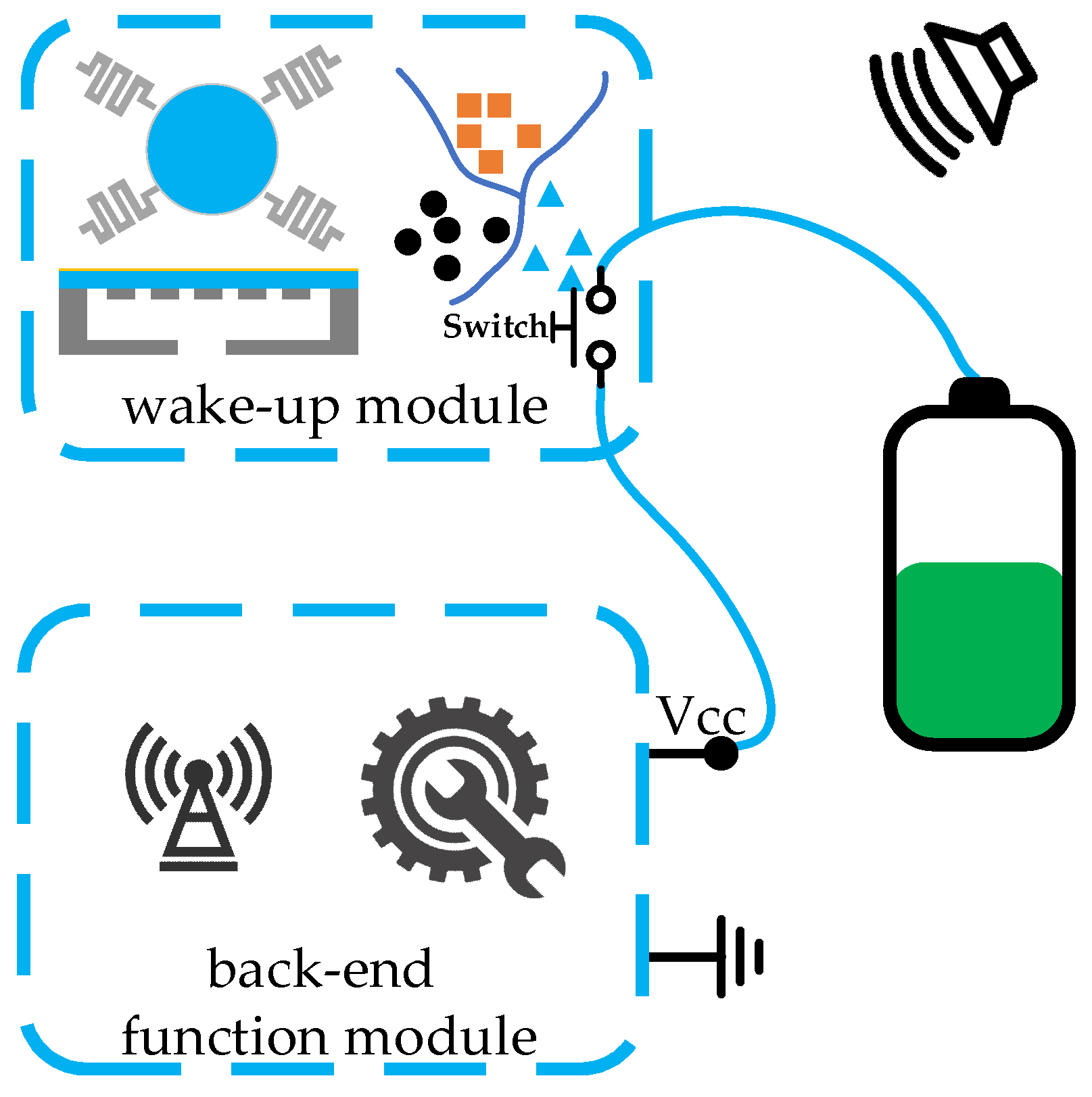Microsystems with capabilities of acoustic signal perception and recognition are widely used in unattended monitoring applications. In order to realize long-term and large-scale monitoring, microsystems with ultra-low power consumption are always required. Acoustic wake-up is one of the solutions to effectively reduce the power consumption of microsystems, especially for monitoring sparse events.
- acoustic wake-up
- microsystem
- system
- long life
1. Introduction
2. System Wake-Up Architecture
Two fundamental modules are required for acoustic wake-up microsystems, which are the wake-up module and the back-end function module. The wake-up module is responsible for acoustic sensing and recognition, and waking up the back-end function module when a specific target appears or a specific event occurs. The back-end function module remains in a low-power or even zero-power sleep mode before waking up, and it performs the main functions of the microsystem after waking up, such as data processing, actuator controlling, and data transceiving. Acoustic wake-up microsystems require ultra-low sleep power consumption and a small size, which results in limited sensing and data processing performance. Although there are many high-performance MEMS acoustic transducers and high-precision classification algorithms applied to the target and event sensing and recognition, not many are able to be implemented in acoustic wake-up microsystems. The system wake-up architectures are divided into 4 categories according to whether the wake-up module or the back-end function module consumes power in sleep mode. The power consumption caused by the current leakage of electronic devices, batteries, etc., is treated as zero power consumption.
2.1. Architecture 1: Low-Power Recognition and Low-Power Sleep
In the low-power recognition and low-power sleep architecture, aka Architecture 1, when the microsystem is in sleep mode, the wake-up module consumes power for acoustic sensing and recognition, while the back-end function module also consumes power waiting for the wake-up signal, usually a voltage signal of high or low, from the wake-up module, as shown in Figure 1. In the back-end function module, there must be a chip capable of switching between high-power active mode and low-power sleep mode. This architecture is the most used and most mature wake-up architecture in various electronic devices, and also in microsystems.

Figure 1. Architecture 1: low-power recognition and low-power sleep.
2.2. Architecture 2: Zero-Power Recognition and Low-Power Sleep
In the zero-power recognition and low-power sleep architecture, aka Architecture 2, the wake-up module performs acoustic sensing and recognition with zero power consumption, while the back-end function module remains the same as in Architecture 1, as shown in Figure 2. Zero-power sensing and data processing technologies, such as high-sensitivity piezoelectric transducers, passive amplifiers, passive filters, and passive classifiers, are required. When the target acoustic signal appears, the wake-up module recognizes it and then generates a wake-up signal for the back-end function module.

Figure 2. Architecture 2: zero-power recognition and low-power sleep.
2.3. Architecture 3: Low-Power Recognition and Zero-Power Sleep
In the low-power recognition and zero-power sleep architecture, aka Architecture 3, the wake-up module performs acoustic sensing and recognition with power consumption, which is similar to the wake-up module in Architecture 1. However, there is a switch in the module, which is used for controlling the current flowing through the back-end functional module, as shown in Figure 3. In addition, a chip with the function of switching working modes in the back-end function module is no longer needed. In sleep mode, the back-end function module is powered off instead of in a low-power sleep state. This switch-included wake-up module is much more universal and can easily be used to reform the wake-up function of various electronic systems. Nonetheless, the switch increases the size and power consumption of the wake-up module.

Figure 3. Architecture 3: low-power recognition and zero-power sleep.
2.4. Architecture 4: Zero-Power Recognition and Zero-Power Sleep
In the zero-power recognition and zero-power sleep architecture, aka Architecture 4, the microsystem consumes absolutely zero power in sleep mode. A wake-up module with zero-power sensing, recognition, and circuit switching is the key to this architecture, as shown in Figure 4. Acoustic sensing, signal processing, and switch actuation are all powered by the energy in the acoustic signal.

Figure 4. Architecture 4: zero-power recognition and zero-power sleep.
3. Applications
3.1. Perimeter Surveillance
3.2. Structure Health Monitoring
3.3. Human Health Monitoring
3.4. Agriculture Application
3.5. Biodiversity Research
3.6. Smart City
4. Challenges and Future Research Directions
4.1. Software
4.2. Hardware
This entry is adapted from the peer-reviewed paper 10.3390/mi14010129
References
- Yang, Deng; Zhao, Jiahao; Acoustic Wake-Up Technology for Microsystems: A Review. Micromachines 2023, 14, 129, 10.3390/mi14010129.
- Zhu, J.; Liu, X.; Shi, Q.; He, T.; Sun, Z.; Guo, X.; Liu, W.; Sulaiman, O.B.; Dong, B.; Lee, C. Development Trends and Perspectives of Future Sensors and MEMS/NEMS. Micromachines 2020, 11, 7.
- Iannacci, J. Microsystem based Energy Harvesting (EH-MEMS): Powering pervasivity of the Internet of Things (IoT)–A review with focus on mechanical vibrations. J. King Saud Univ.-Sci. 2019, 31, 66–74.
- Gazivoda, M.; Bilas, V. Always-on sparse event wake-up detectors: A Review. IEEE Sens. J. 2022, 22, 8313–8326.
- Olsson, R.; Gordon, C.; Bogoslovov, R. Zero and near zero power intelligent microsystems. J. Phys. Conf. Ser. 2019, 1407, 012042.
- Yang, D.; Duan, W.; Xuan, G.; Hou, L.; Zhang, Z.; Song, M.; Zhao, J. Self-Powered Long-Life Microsystem for Vibration Sensing and Target Recognition. Sensors 2022, 22, 9594.
- Cook, E.H.; Tomaino-Iannucci, M.J.; Reilly, D.P.; Bancu, M.G.; Lomberg, P.R.; Danis, J.A.; Elliott, R.D.; Ung, J.S.; Bernstein, J.J.; Weinberg, M.S. Low-Power Resonant Acceleration Switch for Unattended Sensor Wake-Up. J. Microelectromech. Syst. 2018, 26, 1071–1081.
- Pinrod, V.; Pancoast, L.; Davaji, B.; Lee, S.; Ying, R.; Molnar, A.; Lal, A. Zero-Power Sensors with near-Zero-Power Wakeup Switches for Reliable Sensor Platforms. In Proceedings of the 2017 IEEE 30th International Conference on Micro Electro Mechanical Systems (MEMS), Las Vegas, NV, USA, 22–26 January 2017; pp. 1236–1239.
- Wheeler, B.; Ng, A.; Kilberg, B.; Maksimovic, F.; Pister, K.S. A low-power optical receiver for contact-free programming and 3D localization of autonomous microsystems. In Proceedings of the 2019 IEEE 10th Annual Ubiquitous Computing, Electronics & Mobile Communication Conference (UEMCON), New York, NY, USA, 10–12 October 2019; pp. 371–376.
- Wang, P.-H.; Jiang, H.; Gao, L.; Sen, P.; Kim, Y.-H.; Rebeiz, G.M.; Mercier, P.P.; Hall, D.A. A near-zero-power wake-up receiver achieving−69-dBm sensitivity. IEEE J. Solid-State Circuits 2018, 53, 1640–1652.
- Qian, Z.Y.; Kang, S.H.; Rajaram, V.; Cassella, C.; McGruer, N.E.; Rinaldi, M. Zero-power infrared digitizers based on plasmonically enhanced micromechanical photoswitches. Nat. Nanotechnol. 2017, 12, 969–973.
- Mazarakis, G.P.; Avaritsiotis, J.N. Vehicle classification in sensor networks using time-domain signal processing and neural networks. Microprocess. Microsyst. 2007, 31, 381–392.
- Goldberg, D.H.; Andreou, A.G.; Julian, P.; Pouliquen, P.O.; Riddle, L.; Rosasco, R. A wake-up detector for an acoustic surveillance sensor network: Algorithm and VLSI implementation. In Proceedings of the 2004 Third International Symposium on Information Processing in Sensor Networks (IPSN 2004), Berkeley, CA, USA, 27 April 2004; pp. 134–141.
- Kaushik, B.; Nance, D.; Ahuja, K. A Review of the Role of Acoustic Sensors in the Modern Battlefield. In Proceedings of the 11th AIAA/CEAS Aeroacoustics Conference, Monterey, CA, USA, 23–25 May 2005; p. 2997.
- Zhao, Q.; Guo, F.; Zu, X.; Li, B.; Yuan, X. An acoustic-based feature extraction method for the classification of moving vehicles in the wild. IEEE Access 2019, 7, 73666–73674.
- Huang, J.; Zhang, X.; Guo, F.; Zhou, Q.; Liu, H.; Li, B. Design of an acoustic target classification system based on small-aperture microphone array. IEEE Trans. Instrum. Meas. 2014, 64, 2035–2043.
- Ghiurcau, M.V.; Rusu, C.; Bilcu, R.C.; Astola, J. Audio based solutions for detecting intruders in wild areas. Signal Process. 2012, 92, 829–840.
- Yu, Z.-J.; Dong, S.-L.; Wei, J.-M.; Xing, T.; Liu, H.-T. Neural Network Aided Unscented Kalman Filter for Maneuvering Target Tracking in Distributed Acoustic Sensor Networks. In Proceedings of the 2007 International Conference on Computing: Theory and Applications (ICCTA’07), Kolkata, India, 5–7 March 2007; pp. 245–249.
- Höflinger, F.; Hoppe, J.; Zhang, R.; Ens, A.; Reindl, L.; Wendeberg, J.; Schindelhauer, C. Acoustic Indoor-Localization System for Smart Phones. In Proceedings of the 2014 IEEE 11th International Multi-Conference on Systems, Signals & Devices (SSD14), Barcelona, Spain, 11–14 February 2014; pp. 1–4.
- Xiong, C.; Lu, W.; Zhao, X.; You, Z. Miniaturized multi-topology acoustic source localization network based on intelligent microsystem. Sens. Actuators A Phys. 2022, 345, 113746.
- Behnia, A.; Chai, H.K.; Shiotani, T. Advanced structural health monitoring of concrete structures with the aid of acoustic emission. Constr. Build. Mater. 2014, 65, 282–302.
- Baifeng, J.; Weilian, Q. The Research of Acoustic Emission Techniques for Non Destructive Testing and Health Monitoring on Civil Engineering Structures. In Proceedings of the 2008 International Conference on Condition Monitoring and Diagnosis, Beijing, China, 21–24 April 2008; pp. 782–785.
- Li, S.-H.; Lin, B.-S.; Tsai, C.-H.; Yang, C.-T.; Lin, B.-S. Design of wearable breathing sound monitoring system for real-time wheeze detection. Sensors 2017, 17, 171.
- Istrate, D.; Castelli, E.; Vacher, M.; Besacier, L.; Serignat, J.-F. Information extraction from sound for medical telemonitoring. IEEE Trans. Inf. Technol. Biomed. 2006, 10, 264–274.
- Shkel, A.A.; Kim, E.S. Wearable Low-Power Wireless Lung Sound Detection Enhanced by Resonant Transducer Array for Pre-Filtered Signal Acquisition. In Proceedings of the 2017 19th International Conference on Solid-State Sensors, Actuators and Microsystems (TRANSDUCERS), Kaohsiung, Taiwan, 20–24 June 2021; pp. 842–845.
- Nystuen, J.A.; Selsor, H.D. Weather classification using passive acoustic drifters. J. Atmos. Ocean. Technol. 1997, 14, 656–666.
- Baker, D.M.; Davies, K. F2-region acoustic waves from severe weather. J. Atmos. Terr. Phys. 1969, 31, 1345–1352.
- Doohan, B.; Fuller, S.; Parsons, S.; Peterson, E. The sound of management: Acoustic monitoring for agricultural industries. Ecol. Indic. 2019, 96, 739–746.
- Azfar, S.; Nadeem, A.; Alkhodre, A.; Ahsan, K.; Mehmood, N.; Alghmdi, T.; Alsaawy, Y. Monitoring, detection and control techniques of agriculture pests and diseases using wireless sensor network: A review. Int. J. Adv. Comput. Sci. Appl. 2018, 9, 12.
- Budka, M.; Jobda, M.; Szałański, P.; Piórkowski, H. Acoustic approach as an alternative to human-based survey in bird biodiversity monitoring in agricultural meadows. PLoS ONE 2022, 17, e0266557.
- Shorten, P.R.; Welten, B.G. An acoustic sensor technology to detect urine excretion. Biosyst. Eng. 2022, 214, 90–106.
- Marzetti, S.; Gies, V.; Barchasz, V.; Best, P.; Paris, S.; Barthelemy, H.; Glotin, H. Ultra-Low Power Wake-Up for Long-Term Biodiversity Monitorin. In Proceedings of the 2020 IEEE International Conference on Internet of Things and Intelligence System (IoTaIS), Bali, Indonesia, 27–28 January 2021; pp. 188–193.
- Buxton, R.T.; McKenna, M.F.; Clapp, M.; Meyer, E.; Stabenau, E.; Angeloni, L.M.; Crooks, K.; Wittemyer, G. Efficacy of extracting indices from large-scale acoustic recordings to monitor biodiversity. Conserv. Biol. 2018, 32, 1174–1184.
- Desjonquères, C.; Gifford, T.; Linke, S. Passive acoustic monitoring as a potential tool to survey animal and ecosystem processes in freshwater environments. Freshw. Biol. 2020, 65, 7–19.
- Harris III, A.F.; Stojanovic, M.; Zorzi, M. Idle-time energy savings through wake-up modes in underwater acoustic networks. Ad Hoc Netw. 2009, 7, 770–777.
- Wang, D.; Li, H.; Xie, Y.; Hu, X.; Fu, L. Channel-adaptive location-assisted wake-up signal detection approach based on LFM over underwater acoustic channels. IEEE Access 2019, 7, 93806–93819.
- Su, R.; Gong, Z.; Zhang, D.; Li, C.; Chen, Y.; Venkatesan, R. An adaptive asynchronous wake-up scheme for underwater acoustic sensor networks using deep reinforcement learning. IEEE Trans. Veh. Technol. 2021, 70, 1851–1865.
- Qu, B.; Zhang, L.; He, W.; Zhang, T.; Feng, X. LOS Acoustic Signal Recognition Indoor Based on the Dynamic Online Training. In Proceedings of the 2022 IEEE/CIC International Conference on Communications in China (ICCC), Foshan, China, 11–13 August 2022; pp. 280–285.
- Abu-El-Quran, A.R.; Goubran, R.A.; Chan, A.D. Security monitoring using microphone arrays and audio classification. IEEE Trans. Instrum. Meas. 2006, 55, 1025–1032.
- Mielke, M.; Schäfer, A.; Brück, R. Integrated Circuit for Detection of Acoustic Emergency Signals in Road Traffic. In Proceedings of the 17th International Conference Mixed Design of Integrated Circuits and Systems-MIXDES 2010, Wroclaw, Poland, 24–26 June 2010; pp. 562–565.
- Lawson, A.; Vabishchevich, P.; Huggins, M.; Ardis, P.; Battles, B.; Stauffer, A. Survey and Evaluation of Acoustic Features for Speaker Recognition. In Proceedings of the 2011 IEEE International Conference on Acoustics, Speech and Signal Processing (ICASSP), Prague, Czech Republic, 22–27 May 2011; pp. 5444–5447.
- Lin, Z.; Zhang, G.; Xiao, X.; Au, C.; Zhou, Y.; Sun, C.; Zhou, Z.; Yan, R.; Fan, E.; Si, S. A personalized acoustic interface for wearable human–machine interaction. Adv. Funct. Mater. 2022, 32, 2109430.
